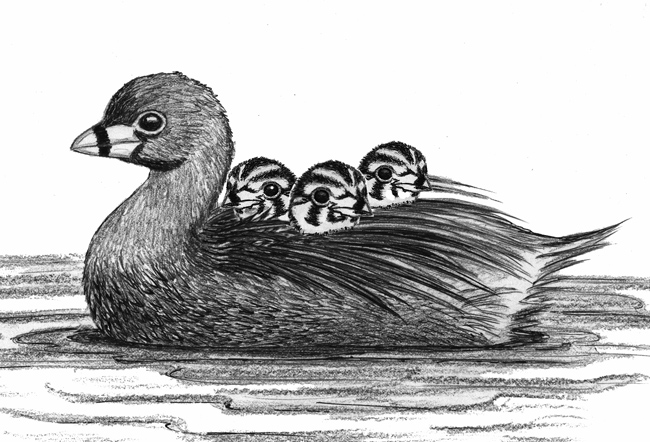
Dear Bird Folks,
I was standing on the bridge that crosses over Harwich’s Herring River today when I saw several small duck-like birds swimming in the water. I didn’t get a good look at them because they dove and didn’t reappear…ever. Could they be the birds pictured here on page 57 of my field guide? More importantly, where did they go?
– Peter, Harwich, MA
Yes, they could be, Peter,
The key phrase is “they could be.” They could have been any number of aquatic birds found on the Herring River this time of year. Given that I wasn’t there, the call is really up to you. But since the birds on page 57 are often seen on that river, you are probably correct. Right now everyone else is wondering what bird is on page 57. It’s a Pied-billed Grebe, which is indeed a small duck-like bird. FYI: Grebe is pronounced with a long e sound, as in dweeb; it’s not a short e, as in Jeb, with or without the exclamation point.
Of the twenty species of grebes found throughout the world, three are regularly seen on Cape Cod, with Pied-billed Grebes being the more common. (Sorry to call your serendipitous grebe discovery “common” but when it comes to bird populations, common is a good thing.) This grebe is called “pied-billed” because its bill is chunky and white with a black band around it (and not, sadly, because its bill is shaped like a delicious slice of pie). One really interesting feature on this bird is its feet. Most waterfowl have the stereotypical duck feet: a solid membrane linking three toes together, thus forming one big paddle. Grebes, on the other hand (or foot), do things differently. Their toes aren’t joined together duck-style. Instead, each toe is flattened out as if someone smashed each one with a hammer, creating three smaller individual paddles. In addition to paddle-toes, grebes have another odd feature. Their legs are located on their extreme back end. I know “extreme back end” sounds like a Kardashian, but those rearward legs help propel grebes quickly through the water. There’s a trade-off, however. Having legs so far back prevents them from walking gracefully on land…if they ever walk at all.
This brings us to the second part of your question. You saw the grebes dive, but they didn’t reappear. Where did they go? I know where they went. They went to Hell…or at least that’s what some people used to think. A folk name for grebes is “helldiver,” because they can seemingly vanish without a trace. Grebes aren’t strong flyers so instead of taking to the air when danger approaches, they hide under water. By absorbing more water into their feathers, grebes have the ability to slowly submerge, without even making a ripple. Once under water, the birds will swim to the nearest vegetation where they will quietly rise to the surface, exposing only their eyes and nostrils. Years ago people didn’t understand what had happened to the birds and thought they simply went to Hell. Don’t ask me why folks thought the birds dove down to Hell. I guess back then Hell was their answer for everything. (I know it was in my house.)
Due to their walking issues, grebes tend to avoid land. In fact, they won’t even build their nests on land. Instead, these water birds construct small islands of floating vegetation. These island platforms, which are anchored to the surrounding plant life, are strong enough to support as many as ten eggs, plus the adults. After the eggs are laid, the female does the majority of the incubation. Meanwhile, the male defends the territory, which he often does in his own creative way. When a rival bird is spotted, the male will dive below the water’s surface and attack from underneath. Like a tiny feathered U-boat, the grebe will strike the surprised intruder from below, causing the panicked trespasser to go away…and never come back. The stunned bird will likely spend the next few days wondering where the heck that crazy grebe came from. (But we know where it came from…Hell.)
Most of North America’s grebe species are handsome, well marked birds, but the Pied-billed Grebe is not one of them. This grebe is short, brown, and chunky, resembling a floating hiking boot. Although it’s a different story for their babies. The super-cute little grebes have well marked black and white striped heads, which makes them look like tiny aquatic tigers. Like most water birds, baby grebes have the ability to swim after hatching, but only for short periods. If they remain in the water too long, they will drown. Fortunately, that doesn’t happen too often. When it’s time to get out of the water, the kids simply climb onto the backs of their parents and ride around for a while, creating one of the most adorable sights you’ll ever see in nature.
I’m glad you saw some Pied-billed Grebes, Peter (at least for a few seconds). Even though their local population has been decreasing in recent years, most Cape Codders can still easily find them by visiting any of the area’s ponds or wetlands. All you have to do is focus your binoculars on anything that looks like a floating hiking boot and it’s likely to be a Pied-billed Grebe. If the hiking boot has a leg attached to it, however, put down your binoculars and call 911.